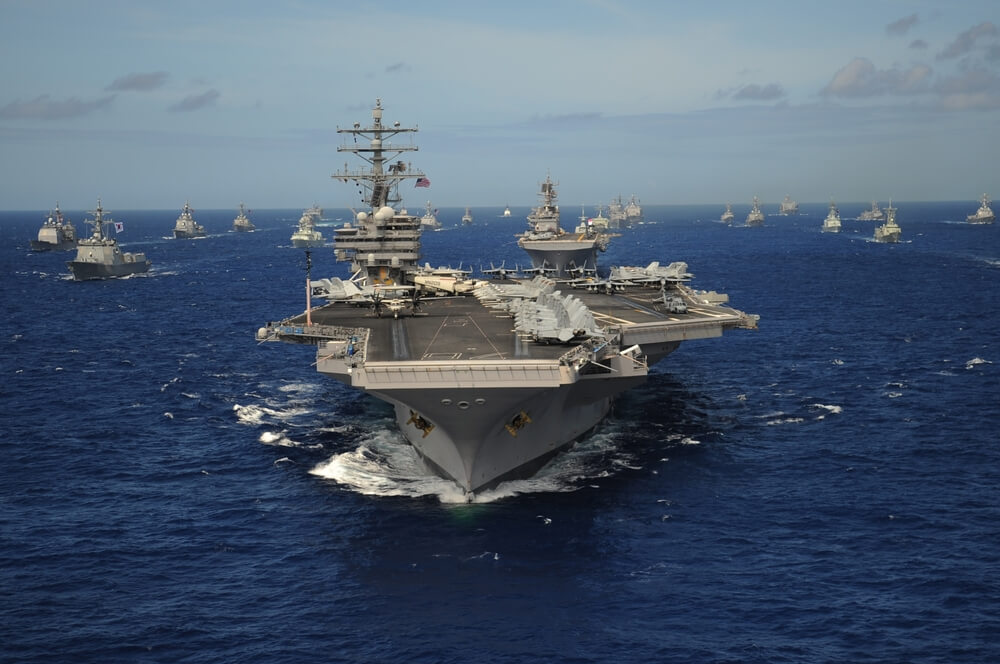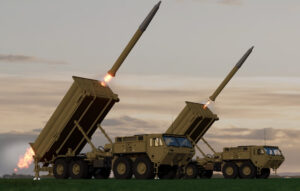Whenever Department of Defense funds are in short supply, U.S. Army officers want to target the aircraft carrier force for cutbacks. This is not surprising as they have been doing this since George C. Marshall was the Army Chief of Staff.
The latest such critique by retired Army Maj. Gen. John Ferrari at American Enterprise Institute unearths yet again all of the same arguments against the big flattops that have advanced since the 1940’s.
The carrier is an expensive piece of hardware for sure, especially when factoring its air wing. The carrier has also always been susceptible to attack, vulnerable to damage primarily due to its mission of being a busy airport in a 1,000- foot-long steel box at sea.
Despite these critiques, the carrier remains an incredibly flexible platform due to the infinite changes possible in its main battery air wing. The exercise of sea control is not possible in the absence of air superiority provided by carrier-based aircraft, both manned and unmanned.
The Navy is already on course toward a 60% unmanned air wing in the next 15 years, with some manned aircraft required to team with them. The F/A-XX provides the capability to coordinate unmanned aircraft, an essential function proved during the recent Israel-Iran conflict when Israeli aircraft and ground defense slaughtered uncoordinated Iranian drones.
If anything, the Navy’s carrier force remains too small to adequately source the missions to which national command leadership details them.
Unsupported historical critiques
The “carrier is the new battleship” argument advanced by Ferrari is one of the poorest arguments yet made against the carrier. Battleships could absorb much more damage than carriers during World War II. It took nearly 400 aircraft, launched from 15 U.S. carriers to inflict a dozen torpedo and 15 bomb hits on the Japanese super battleship Yamato during its one-way, kamikaze mission to Okinawa in 1945. It was merely a repeat of the sinking of HMS Prince of Wales and HMS Repulse in 1941, where capital ships without air cover were overwhelmed and sunk.
The carrier is equally vulnerable to mass attack, and its unstealthy, large flat deck and regular air operations make it even more so a target. The carrier, however, replaced the battleship as the primary surface sea combatant because it can deliver combat power at much longer ranges over longer periods of time than a battle wagon armed with guns.
The carrier also provides air superiority at sea that is vital for sea control. The British ships in 1941 and Yamato in 1945 were sunk because they lacked defensive counter aviation capabilities. A mass of missile-armed drones would be just as easily sunk in the absence of air coverage. Missile-armed smaller craft also lack the staying power of the carrier airwing in terms of combat delivery of munitions. These important historical lessons are lost in simple meme-like comparisons of the battleship and the carrier.
Air wing of the future
Apparently, Ferrari missed the Navy announcement that the carrier air wing was headed toward a 60% unmanned capacity by 2040. That’s a much more detailed plan than anything the other services are doing in terms of bringing unmanned aircraft, including the M/Q-25A Stingray tanker fully into operational service.
The video “Sea Strike 2043,” debuted at the 2025 Surface Navy Association conference in Washington, D.C., detailed the idea of manned/unmanned teaming that future carrier air wings would employ. Part of the carrier’s longevity and value over decades is in its ever-changeable air wing composition, a feature that allows even older carriers like the USS Carl Vison to operate the fleet’s newest aircraft, the F-35C, a plane not yet conceived when Vinson entered service in 1982.
Drones no doubt add combat advantage, and in naval warfare their emergence as effective weapons in the Russian war against Ukraine and in the Red Sea make littoral ocean spaces more hostile environments for warships of all types. But drones work in the Black Sea because there is no “tyranny of distance,” to overcome in the mostly short-range employment of weapons in Russia’s war on Ukraine.
In the Indo-Pacific, however, drones must travel hundreds or thousands of miles to reach their targets on a lithium battery or small internal combustion engine that provides speed or range, but not both.
The Iranians and Houthis tried to do this with drone launches against Israel and U.S. warships in the Red Sea. The U.S. and Israel identified and downed the drones in nearly all cases far from their intended targets. In 2024 and 2025, the U.S. military downed hundreds of Iranian and Houthi drones. The Navy played a paramount role in that effort. If the Navy were truly “broken,” as Ferrari maintains, then Israel would have been a smoldering datum in the wake of those attacks.
Navy is not broken
The Navy is far from being a broken service, but it has serious challenges in ship repair and maintenance and in new shipbuilding, due in large part to the deindustrialization of the nation after the Cold War, spearheaded by Defense Secretary Les Aspin and his deputy William Perry’s infamous “last supper” event, where Perry told defense companies to consolidate or face dissolution.
The nation told its young people to stay away from trade education and send everyone to college. These are national and not Navy problems with which the nation still wrestles.
The Navy is guilty of an overly “can do” attitude in sometimes achieving miracles to deploy ships, submarines and aircraft to conduct assurance, deterrence and if necessary compellence missions against adversaries in support of the national interest.
Carriers are e often the first choice of Presidents in those efforts due to their high speed and lethal complement of strike aircraft. . No president asks, “Where is the nearest brigade combat team” when contemplating military action. U.S. Navy admirals need to “pound the table” as famous Adm. Arleigh Burke once advised and be clear with civilian leaders on the capabilities and limitations of the service to execute combat operations over time.
Navy leadership is not “dominated” by naval aviators, as Ferrari maintains, and no aviator has served as Chief of Naval Operations in a quarter century. Angry, Army hyperbole ought best to be ignored here, just as Franklin Roosevelt tended to ignore George C. Marshall when he became jealous of the Navy’s budget.
Aircraft carriers will continue to form a significant element of U.S. Navy combat capability well into the 21st century. The Navy ought to speed the development of the M/Q-25A and strike variants of that aircraft for the future carrier air wing. Achieving sea control, and especially command of the sea in any region, is a joint force endeavor. But in the absence of terrestrial air bases in many regions, naval aircraft provide the only source for achieving air superiority.
It’s no longer the uncontested sea control world of the last 35 years, but carriers will continue to play vital roles in both offensive and defensive operations in contested seas.







